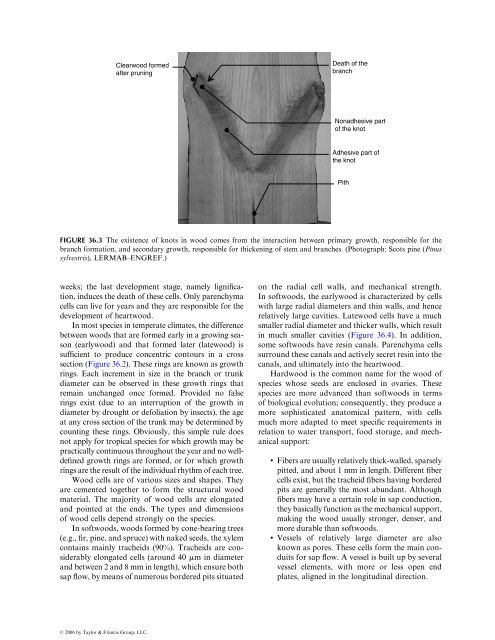36 Drying of Wood
36 Drying of Wood
36 Drying of Wood
- No tags were found...
You also want an ePaper? Increase the reach of your titles
YUMPU automatically turns print PDFs into web optimized ePapers that Google loves.
Clearwood formedafter pruningDeath <strong>of</strong> thebranchNonadhesive part<strong>of</strong> the knotAdhesive part <strong>of</strong>the knotPithFIGURE <strong>36</strong>.3 The existence <strong>of</strong> knots in wood comes from the interaction between primary growth, responsible for thebranch formation, and secondary growth, responsible for thickening <strong>of</strong> stem and branches. (Photograph: Scots pine (Pinussylvestris), LERMAB–ENGREF.)weeks; the last development stage, namely lignification,induces the death <strong>of</strong> these cells. Only parenchymacells can live for years and they are responsible for thedevelopment <strong>of</strong> heartwood.In most species in temperate climates, the differencebetween woods that are formed early in a growing season(earlywood) and that formed later (latewood) issufficient to produce concentric contours in a crosssection (Figure <strong>36</strong>.2). These rings are known as growthrings. Each increment in size in the branch or trunkdiameter can be observed in these growth rings thatremain unchanged once formed. Provided no falserings exist (due to an interruption <strong>of</strong> the growth indiameter by drought or defoliation by insects), the ageat any cross section <strong>of</strong> the trunk may be determined bycounting these rings. Obviously, this simple rule doesnot apply for tropical species for which growth may bepractically continuous throughout the year and no welldefinedgrowth rings are formed, or for which growthringsare the result <strong>of</strong> the individual rhythm<strong>of</strong>eachtree.<strong>Wood</strong> cells are <strong>of</strong> various sizes and shapes. Theyare cemented together to form the structural woodmaterial. The majority <strong>of</strong> wood cells are elongatedand pointed at the ends. The types and dimensions<strong>of</strong> wood cells depend strongly on the species.In s<strong>of</strong>twoods, woods formed by cone-bearing trees(e.g., fir, pine, and spruce) with naked seeds, the xylemcontains mainly tracheids (90%). Tracheids are considerablyelongated cells (around 40 mm in diameterand between 2 and 8 mm in length), which ensure bothsap flow, by means <strong>of</strong> numerous bordered pits situatedon the radial cell walls, and mechanical strength.In s<strong>of</strong>twoods, the earlywood is characterized by cellswith large radial diameters and thin walls, and hencerelatively large cavities. Latewood cells have a muchsmaller radial diameter and thicker walls, which resultin much smaller cavities (Figure <strong>36</strong>.4). In addition,some s<strong>of</strong>twoods have resin canals. Parenchyma cellssurround these canals and actively secret resin into thecanals, and ultimately into the heartwood.Hardwood is the common name for the wood <strong>of</strong>species whose seeds are enclosed in ovaries. Thesespecies are more advanced than s<strong>of</strong>twoods in terms<strong>of</strong> biological evolution; consequently, they produce amore sophisticated anatomical pattern, with cellsmuch more adapted to meet specific requirements inrelation to water transport, food storage, and mechanicalsupport:. Fibersareusuallyrelativelythick-walled,sparselypitted, and about 1 mm in length. Different fibercells exist, but the tracheid fibers having borderedpits are generally the most abundant. Althoughfibers may have a certain role in sap conduction,theybasicallyfunctionasthemechanicalsupport,making the wood usually stronger, denser, andmore durable than s<strong>of</strong>twoods.. Vessels <strong>of</strong> relatively large diameter are alsoknown as pores. These cells form the main conduitsfor sap flow. A vessel is built up by severalvessel elements, with more or less open endplates, aligned in the longitudinal direction.ß 2006 by Taylor & Francis Group, LLC.
















